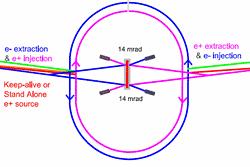Director's Corner
21 December 2006
 Barry Barish |
The Evolving ILC Design: Centralising the Injectors
I report today on another design change that has resulted from our ongoing cost to performance optimisation studies, which we are carrying out before finalising the ILC reference design. In my column from 5 October 2006, I described advances in our understanding of electron cloud effects. These studies allowed us to make a change to the ILC baseline from two positron rings receiving alternate bunches to one ring, in which we believe we can mitigate such effects. It turns out that making this change opened up the possibility to make a further change -- move both the positron and electron ring to a shared single tunnel at the centre of the ILC. The GDE Change Control Board (CCB) and the GDE Executive Committee recently approved this change. Compared to other changes we have made, this one is so visible that it dramatically changes the characteristic plan view of the ILC.
 The new layout of the ILC central 4.5 km beam delivery system with accelerated beams entering from the left and right. The interaction points are now surrounded by electron and positron sources and the 6.7 km damping rings. |
In principle, moving the damping rings to the centre will not affect physics performance. For that reason, this change request did not require studies or interactions with the physics community. Instead, the subtleties and complications in developing and evaluating this proposal come from the fact that it touches so many different accelerator subsystems: the sources, beam lines and so on. In order to coordinate and understand the effects on all these various systems, we called upon our integration scientist, Ewan Paterson, who did a terrific job of working all these complex issues and submitting the change request.
The primary reason driving this change is the substantial cost savings. But, maybe I should reflect a little on the downsides of making this change. In fact there are several concerns and these were debated during the deliberations.
One challenge for this new topology is that it requires long low-emittance 5 GeV beamlines to transport the electrons and positrons from the injector complex all the way to the beginning of the main linacs. Special care will need to be taken in beam dynamics to preserve the low emittance. However, preliminary studies of the new proposed layout show no fundamental problems and were deemed to give acceptable performance. Nevertheless, we will need to monitor and study these beam dynamics questions carefully during the ILC engineering design phase.
The Change Control Board has the task of assessing proposed changes from the viewpoints of their impact on performance, cost and risk. One concern for this particular change is the increased risk. The increased risk in this case results first from the fact that we went from two rings to one ring for positrons, encouraged by electron cloud studies. That change was approved in the context of having a separate positron damping ring tunnel, where there is a natural fallback of installing a second ring if necessary. In the new central damping ring configuration, which has a single tunnel with both an electron and a positron ring, it is less clear what will be involved if we require a second positron ring.
Nevertheless, on balance, the technical issues regarding the beam dynamics in the long beam transports, and the added risk coming from eliminating the easier fallback option for electron cloud effects, were considered tolerable by the CCB when weighed against the very large cost savings resulting from eliminating an entire 6.7 km tunnel. As a result, they approved the change. It represents yet another significant step in the evolving ILC design.
This is my last column before the New Year. Therefore, I would like to close out by wishing you all a very happy holiday season, and most of all, I hope that the New Year will bring peace to the world!
-- Barry Barish